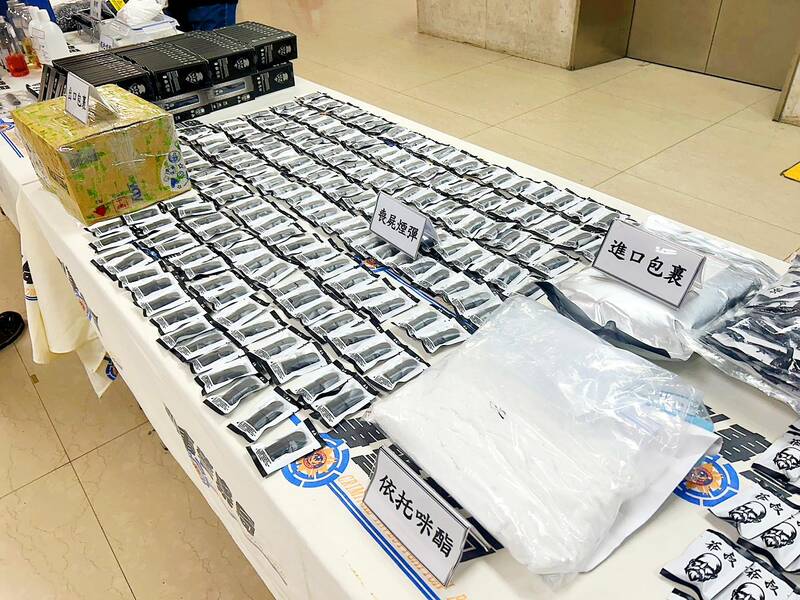The Executive Yuan yesterday passed a new phase of its anti-drug strategy plan, which includes NT$15 billion (US$460.89 million) for enforcement efforts.
The funding would go toward reducing the supply of new drugs such as etomidate, as well as limiting access to the chemicals needed to manufacture them, Deputy Minister of Justice Huang Shih-chieh (黃世杰) told a news conference in Taipei.
High-tech detection methods would be implemented to crack down on Internet-based drug trafficking, with the strategy also calling for cross-border cooperation and intelligence sharing, Huang said.

Photo: Chiu Chun-fu, Taipei Times
The High Prosecutors’ Office is integrating anti-drug resources into its six major enforcement agencies to ensure source tracking and cross-agency cooperation, he said.
For serious cases involving drugs such as etomidate, also known as the “zombie vape” drug, prosecutors would push to seize the proceeds of crimes, he said.
As etomidate is mostly consumed in vape form, Ministry of Health and Welfare officials are coordinating with law enforcement personnel to limit the spread of e-cigarettes using provisions of the Tobacco Hazards Prevention Act (菸害防制法), he said.
Testing capacity will have to be upgraded, with the Food and Drug Administration providing guidance for private institutes to be certified for such processes, he said.
Executive Yuan spokeswoman Michelle Lee (李慧芝) told the news conference that Premier Cho Jung-tai (卓榮泰) has instructed the prosecutors’ office to increase efforts to inhibit narcotics-related crime.
Prosecutors, police, investigative units, military police, coast guard personnel and customs units should be integrated to stop illegal narcotics from entering Taiwan, Lee cited Cho as saying.
The Executive Yuan yesterday approved a Ministry of Justice narcotics review committee plan to reclassify etomidate as a Category 2 narcotic.
It was reclassified as a Category 3 drug in June as a result of rising abuse of the drug in e-cigarettes.
Reclassification to Category 2 means increased penalties for manufacturing, trafficking, transporting and selling etomidate compared with Category 3 drugs, he said.
It also means that possession or use of the drug is a crime, he said.
The Narcotics Hazard Prevention Act (毒品危害防制條例) stipulates that people convicted of using a Category 2 narcotic face a maximum three-year prison term.
Those convicted of possessing it face a maximum two-year term, detention or a fine of no more than NT$200,000, the narcotics act says.
Those convicted of manufacturing, transporting or selling Category 2 narcotics are subject to life imprisonment or a minimum 10-year term and a maximum fine of NT$15 million.
There have been several high-profile cases of “zombie vape” use in the past few months.
On Sunday, a conscript at a military training center was allegedly found in possession of 50 etomidate cartridges, while earlier this year, a police officer was killed by a driver under the drug’s influence.
Additional reporting by CNA

‘CHARM OFFENSIVE’: Beijing has been sending senior Chinese officials to Okinawa as part of efforts to influence public opinion against the US, the ‘Telegraph’ reported Beijing is believed to be sowing divisions in Japan’s Okinawa Prefecture to better facilitate an invasion of Taiwan, British newspaper the Telegraph reported on Saturday. Less than 750km from Taiwan, Okinawa hosts nearly 30,000 US troops who would likely “play a pivotal role should Beijing order the invasion of Taiwan,” it wrote. To prevent US intervention in an invasion, China is carrying out a “silent invasion” of Okinawa by stoking the flames of discontent among locals toward the US presence in the prefecture, it said. Beijing is also allegedly funding separatists in the region, including Chosuke Yara, the head of the Ryukyu Independence

UNITED: The premier said Trump’s tariff comments provided a great opportunity for the private and public sectors to come together to maintain the nation’s chip advantage The government is considering ways to assist the nation’s semiconductor industry or hosting collaborative projects with the private sector after US President Donald Trump threatened to impose a 100 percent tariff on chips exported to the US, Premier Cho Jung-tai (卓榮泰) said yesterday. Trump on Monday told Republican members of the US Congress about plans to impose sweeping tariffs on semiconductors, steel, aluminum, copper and pharmaceuticals “in the very near future.” “It’s time for the United States to return to the system that made us richer and more powerful than ever before,” Trump said at the Republican Issues Conference in Miami, Florida. “They

GOLDEN OPPORTUNITY: Taiwan must capitalize on the shock waves DeepSeek has sent through US markets to show it is a tech partner of Washington, a researcher said China’s reported breakthrough in artificial intelligence (AI) would prompt the US to seek a stronger alliance with Taiwan and Japan to secure its technological superiority, a Taiwanese researcher said yesterday. The launch of low-cost AI model DeepSeek (深度求索) on Monday sent US tech stocks tumbling, with chipmaker Nvidia Corp losing 16 percent of its value and the NASDAQ falling 612.46 points, or 3.07 percent, to close at 19,341.84 points. On the same day, the Philadelphia Stock Exchange Semiconductor Sector index dropped 488.7 points, or 9.15 percent, to close at 4,853.24 points. The launch of the Chinese chatbot proves that a competitor can

‘VERY SHALLOW’: The center of Saturday’s quake in Tainan’s Dongshan District hit at a depth of 7.7km, while yesterday’s in Nansai was at a depth of 8.1km, the CWA said Two magnitude 5.7 earthquakes that struck on Saturday night and yesterday morning were aftershocks triggered by a magnitude 6.4 quake on Tuesday last week, a seismologist said, adding that the epicenters of the aftershocks are moving westward. Saturday and yesterday’s earthquakes occurred as people were preparing for the Lunar New Year holiday this week. As of 10am yesterday, the Central Weather Administration (CWA) recorded 110 aftershocks from last week’s main earthquake, including six magnitude 5 to 6 quakes and 32 magnitude 4 to 5 tremors. Seventy-one of the earthquakes were smaller than magnitude 4. Thirty-one of the aftershocks were felt nationwide, while 79